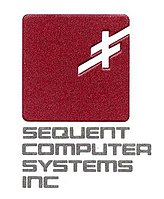Sequent Computer Systems
 |
|
| Industry | High-end computer hardware |
|---|---|
| Fate | Acquired |
| Successor | IBM |
| Founded | 1983 |
| Defunct | 1999 |
Sequent Computer Systems was a computer company that designed and manufactured multiprocessing computer systems. They were among the pioneers in high-performance symmetric multiprocessing (SMP) open systems, innovating in both hardware (e.g., cache management and interrupt handling) and software (e.g., read-copy-update).
Through a partnership with Oracle Corporation, Sequent became a dominant high-end UNIX platform in the late 1980s and early 1990s. Later they introduced a next-generation high-end platform for UNIX and Windows NT based on a non-uniform memory access architecture, NUMA-Q. As hardware prices fell in the late 1990s, and Intel shifted their server focus to the Itanium processor family, Sequent joined the Project Monterey effort in October 1998. which aimed to move a standard Unix to several new platforms.
In July 1999 Sequent agreed to be acquired by IBM. At the time, Sequent's CEO said its technology would "find its way through IBM's entire product field" and IBM announced it would "both sell Sequent machines, and fold Sequent's technology...into its own servers", but by May 2002 a decline in sales of the models acquired from Sequent, among other reasons, led to the retirement of Sequent-heritage products.
Vestiges of Sequent's innovations live on in the form of data clustering software from PolyServe (subsequently acquired by HP), various projects within OSDL, IBM contributions to the Linux kernel, and claims in the SCO v. IBM lawsuit.
...
Wikipedia
